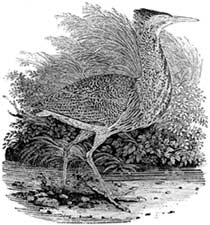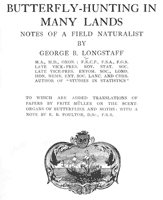Issue 6 : Hound, Chapters 7 and 8
"Did you ever hear a bittern booming?"
The bittern is a marsh heron that almost became extinct in Conan Doyle's
time. Its weird "booming"—said to sound like air being blown over
the top of an empty bottle—has contributed to local legends. Its
usual habitat is reedy swamps, but it would not be expected to occur on
the moor.
A bittern, drawn by British naturalist Thomas Bewick (1753-1828) for his two-volume work, A History of British Birds |
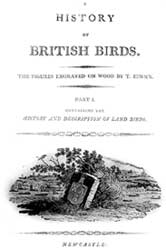 | |
The whole steep slope
was covered with grey circular rings of stone, a score of them at least.
"What are they? Sheep-pens?"
"No, they are the homes of our worthy ancestors. Prehistoric
man lived thickly on the moor, and as no one in particular has lived there
since, we find all his little arrangements exactly as he left them. These
are his wigwams with the roofs off. You can even see his hearth and his
couch if you have the curiosity to go inside."
"But it is quite a town. When was it inhabited?"
"Neolithic man—no date."
Although Neolithic (and even earlier) humans did populate the moor, the
large concentration of visible stone ruins dates from the Bronze Age (2,300
to 700 B.C.). Dartmoor has experienced roughly ten million years of human
habitation and use—with visible remains from at least four million years.
The land is dotted with burial mounds, cairns, and religious monuments
from several different eras—both ancient stone circles and crude medieval
stone crosses. The ruins of stone huts remain, too, but are usually less
complete than the ones Watson describes in Hound. The moor has
served as burial ground, farmland, a place where mining and crude smelting
was performed, as foraging and grazing land, and, since 1951, as a national
park. Visit the Dartmoor National Park Authority's website for pictures
and more information about the 368 square-acre park: www.dartmoor-npa.gov.uk.
Half a century
before the publication of The Hound of the Baskervilles,
a 19th-century vicar of Devon named Samuel Rowe wrote
a guidebook called A Perambulation of the Ancient and Royal
Forest of Dartmoor (1848). The book's illustrations show views
of the various types of rock circles that Dr. Watson—and Conan Doyle,
when he traveled to Dartmoor before writing Hound—might have observed.
The ruins of Bronze Age and Iron Age (700 B.C. to 100 A.D.) villages,
some built on fortified platforms of earth surrounded by stone walls,
can still be seen on Dartmoor today. Some villages consist solely
of low stone circles, while others have higher walls. No roofs remain;
these would have been constructed of timber or thatch.
Some stone circles had a cairn in the middle, probably marking
a burial place.
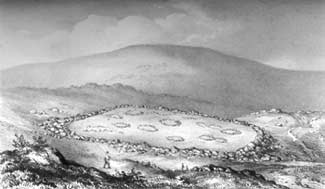 |
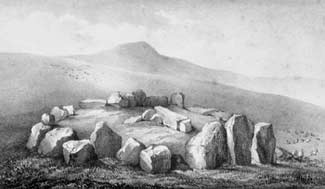 | |
The
remains of a fortified Bronze-Age village—stone rings
mark where huts were built |
A
burial circle with Hound Tor rising in the background | |
Some stone circles or lines of upright stones were probably
used for religious rites or astronomical observations. Bronze Age sites
like this, such as Stonehenge, exist all over England and Western Europe,
but their meaning has been lost.
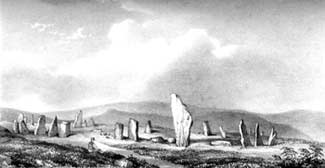 |
A "sacred
circle" of granite slabs, arranged for some unknown purpose |
Butterfly
collecting was a common gentleman's hobby in Conan Doyle's
time |
"Oh, excuse me an instant! It is surely Cyclopides."
A small fly or moth had fluttered across our path, and in an instant Stapleton was rushing with extraordinary energy and speed in pursuit of it.
As he often did, Conan Doyle apparently pulled a species name out of the air to designate Stapleton's butterfly. This species name is outdated, and was used to designate a group of species of insect, rather than one specific type. In any case, no insect named Cyclopides is found in Dartmoor at any time of the year. Many other butterfly species do make the moor their home.
"Will you come upstairs,
Dr. Watson, and inspect my collection of lepidoptera?"
Butterfly collecting was one of the most popular naturalist crazes
of Victorian times. Many private gentlemen had museum-quality collections
assembled through collection and purchase.
One page is missing….
Which page this could have been, no one knows, since the report
seems complete as it stands. Watson never mentions it again, but
Sherlockians have argued over which information might have been
missing from Watson's report.
The strange thing is that they should have lived so thickly on what must always have been most unfruitful soil.
Climate changes, overfarming, and the stripping away of the forest (completed in the Middle Ages) have made Dartmoor more uninhabitable now than in prehistoric times; however, over 33,000 people still live there.
He has been excavating a barrow at Long Down, and has got a prehistoric skull which fills him with great joy.
A barrow is a prehistoric burial mound. Earthen burial mounds are among the only Neolithic (4,500 to 2,300 B.C.) remains on the moor, although a few stone rows also date from this period.
…there are rumours that he intends to prosecute Dr. Mortimer for opening a grave without the consent of the next-of-kin, because he dug up the neolithic skull in the barrow on Long Down. He helps to keep our lives from being monotonous and gives a little comic relief where it is badly needed.
As the self-appointed gadfly of the neighborhood, Mr. Frankland's frivolous lawsuits are often based on literal (and absurd) interpretations of the law.
…and sometimes I suspect Barrymore of being a domestic tyrant.
Watson uses a euphemism to express his suspicion that Barrymore
beats his wife. In England at the turn of the 20th century,
married women have gave up all property rights upon marriage, and
they could only obtain a divorce after proving adultery and
physical cruelty. Conan Doyle, who believed that women should not
have the vote because they did not pay taxes, championed divorce
law reform. Female characters under the power of a husband who is
a psychological bully often appear in Conan Doyle's work. In his
private life, Conan Doyle did not take advantage of his greater
access to divorce as a man: far from attempting to divorce his first
wife, even when he fell in love with another woman, he did all he
could to cure his wife's tuberculosis, and refused to have an affair.
